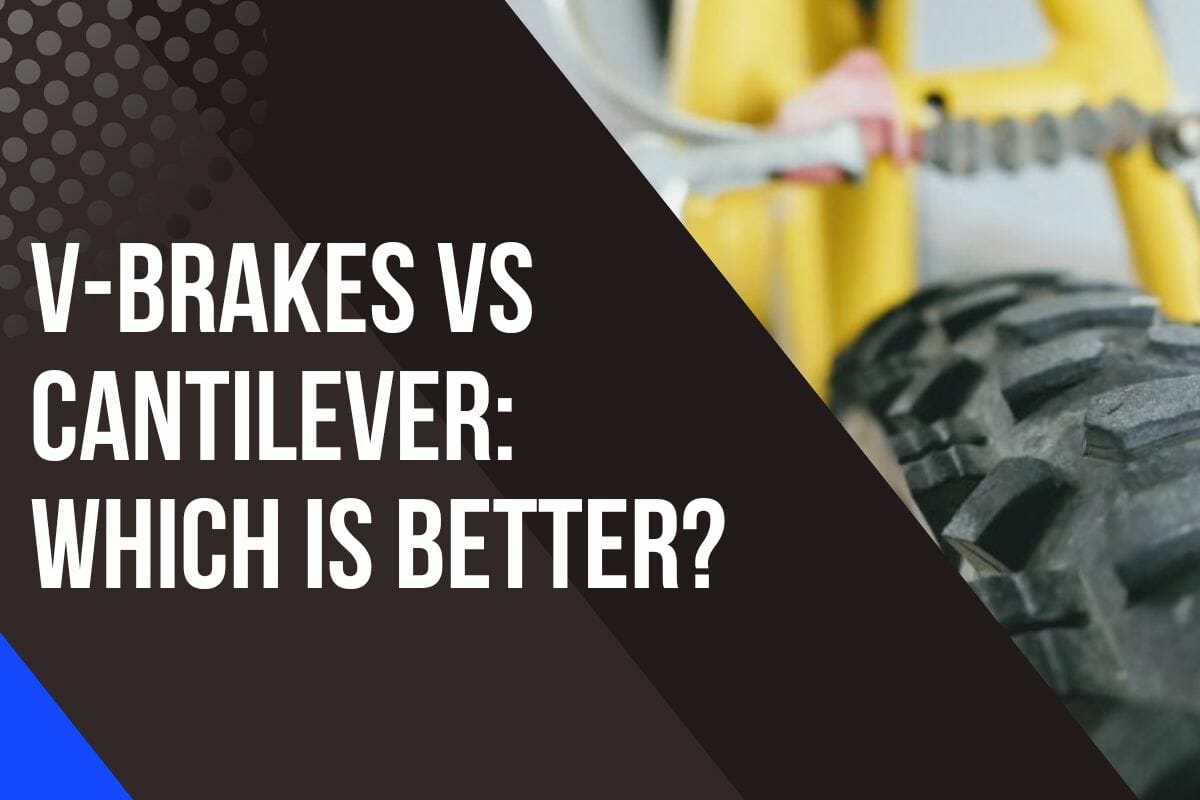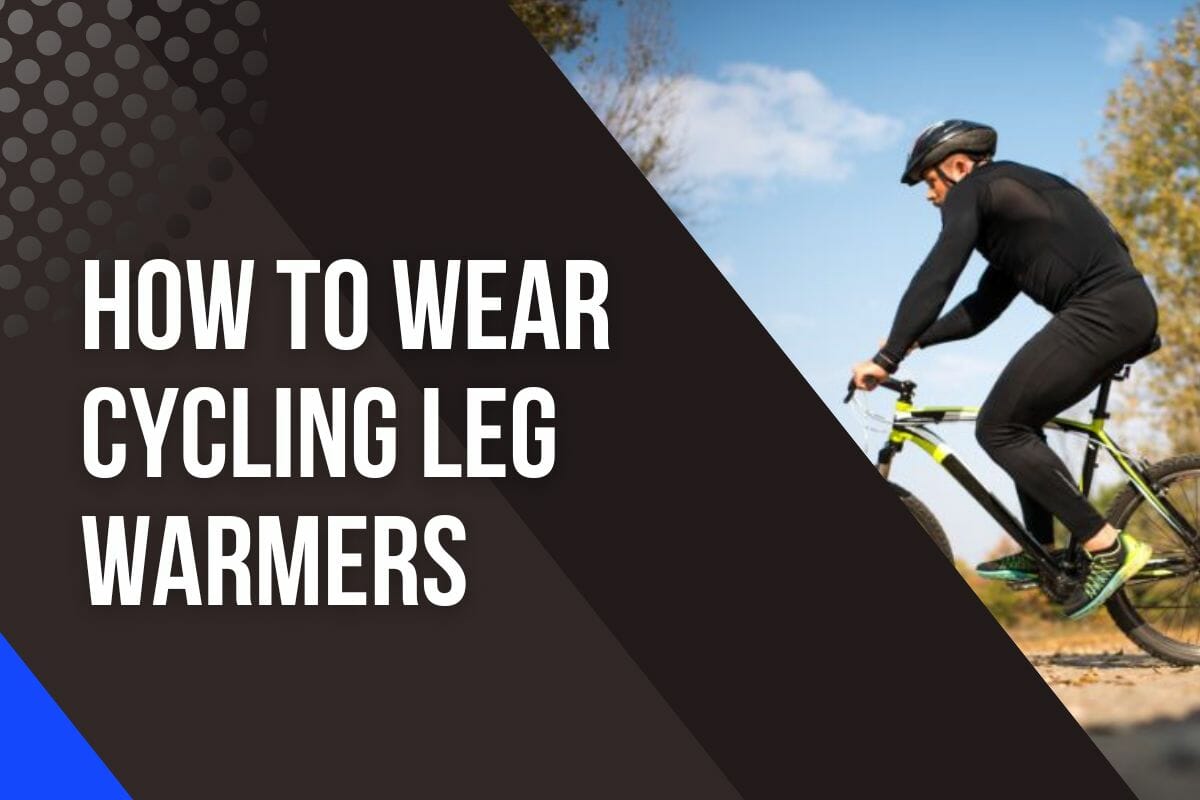V-Brakes vs Cantilever: Which is Better?

Are you in the market for a new bike or considering upgrading your current one? If so, you’re probably familiar with the debate over v brakes vs cantilevers.
There are advantages and disadvantages to both options, making it a difficult decision to determine which is the most suitable for you.
In this article, we’ll take a deep dive into the differences between v brakes and cantilevers, exploring their strengths and weaknesses in various cycling scenarios.
How to Differentiate V Brakes from Cantilever Brakes?
Brakes can be a real pain to understand – all the different terms can be a bit confusing.
Let me break it down for you: V brakes and cantilever brakes are not the same thing. They may both be caliper brakes, but they have some key differences.
Cantilever brakes have two wires that connect in an upside-down V shape at the top of the brakes, while V brakes have a horizontal connection above the tire.

Another name for V brakes is linear brakes – which makes sense when you think about it. The part of the brake that squeezes together is flat and straight, giving it that linear shape.
But don’t worry if you’re having trouble telling these brakes apart. All you need to do is take a peek at the brakes on the front tire.
If the wires form an upside-down V and connect at a single point about 3 inches (7.5 cm) above the tire, then you’ve got yourself some cantilever brakes.
V Brakes Create a V Shape Only When They are Applied
They are called V brakes because the brake arms form a V when the brakes are squeezed.
The V brake system consists of two brake arms and brake pads on each arm. The brake arms are attached to the bike frame or fork via a brake boss.
Pulling the brake lever activates the brake cable, which in turn pulls on a bolt attached to the brake arm.
As a result, both brake arms move inward towards the rim of the tire, causing the brake pads to push against the rim.
The Advantages of Cantilever Brakes Over V Brakes

While V brakes have been the more popular option in recent years due to their modern design and easy maintenance, cantilever brakes offer a few advantages that make them a worthwhile alternative.
Compatible with Drop Bar Brake-Shifters
One of the cantilever brakes’ advantages is their compatibility with drop bar brake shifters.
While V brakes are typically designed for use with mountain bike-style shifters, cantilever brakes are a suitable option for road cyclists using drop bar shifters.
This makes them a more versatile option for riders who alternate between road and off-road terrain.
Retro Appearance
In addition to their functional advantages, cantilever brakes offer a retro appearance that many cyclists find appealing.
They have a classic design that hearkens back to the early days of cycling, and can add a touch of old-school charm to any bike.
This makes them a popular choice among cyclists who appreciate the aesthetic value of their equipment.
Maintenance-Free
Unlike traditional rim-style brakes which need regular adjustment and tuning in order to remain silent and effective, cantilever brakes don’t need much attention at all – just a few quick checks for wear and tear from time to time.
They don’t require any cable tension adjustment either so there’s less risk of straining or damaging them over time.
And since they use sealed bearings in their pivoting points, rebalancing them after installation is rarely ever necessary either – meaning they won’t get too loose or too tight in wet conditions as can be common with rim brakes.
Seamless Wheel Removal
To safely remove the wheels from a bike with a V brake system or any other type of brake system, it is important to ensure that the brakes are disengaged and the cables are tightly bound against the frame.
Next, carefully loosen any bolts securing the wheel in place, such as axle nuts or quick-release levers, and hold onto these fasteners to prevent them from flying off.
However, if you have cantilever brakes then you can enjoy an even simpler seamless process for wheel removal because all that needs to be done is releasing two bolts at either side of each brake caliper – one at each arm’s.
The Advantages Of V Brakes Over Cantilever Brakes
V-brakes have become increasingly popular because they offer a number of advantages over traditional cantilever brakes.
Below, we will explore the advantages of V brakes over cantilever brakes, so you can better understand which type of brake is best for your bike riding goals and preferences.
V brakes are Easier to Squeeze and Use
The V brake design enables the brake pads to clamp down on the wheel rim from both sides, creating a powerful stopping force.
This mechanism makes V brakes more responsive, providing better traction control and a more comfortable braking experience.
V brakes are designed to offer powerful braking even in unexpected situations. For instance, when you’re biking downhill or on a wet surface, V brakes can provide the required stopping power without compromising comfort and safety.
They are also a more affordable option compared to other braking systems like hydraulic rim brakes or hydraulic disc brakes.
No Cables Exposure
One of the main benefits of V-brakes is that the transverse cable is no longer present. This means that no cables are exposed, making them less prone to damage and improving the overall aesthetics of your bike.
Minimal Adjustment & Consistent Performance
The mechanical advantage of V-brakes comes pre-set, so they are easier to understand and maintain, requiring only minimal adjustments to get optimal braking power.
V-brakes also provide more consistent performance in various weather conditions since there are fewer components that can be affected by rain or dirt.
Compatible with Suspension Fork
Bikes with suspension forks may not be compatible with cantilever brakes, and even if they are, their performance is typically inferior to modern brakes.
Also, using a cable hanger to install cantilever brakes on modern bikes just won’t cut it. They simply can’t convert input force to mechanical force as effectively as V-brakes can.
But V-brakes are here to save the day. They offer way more options for bikes with suspension forks and, best of all, they perform like a dream compared to their cantilever counterparts.
Limitations of V Brakes
One of the primary issues with V brakes is their performance in wet conditions.
Mud and water can significantly impact the braking power of V brakes, causing them to feel less responsive and less effective.
the constant exposure to moisture can also cause wear and tear on the rim over time, reducing its lifespan.
As a result, riders may find themselves needing to replace their wheels more frequently when using V brakes in muddy or wet environments.
V brakes & Cantilever Brakes Comparisons
Both have their advantages and disadvantages and which one is right for you depends on your riding style and preferences.
Below, we’ll take a closer look at the differences between V brakes and cantilever brakes and how they stack up against each other.
1. Difference In Mechanical Advantage
V brakes hold an advantage over cantilever brakes.
It comes with a fixed mechanical advantage, which can be a blessing or a curse depending on the user’s preference.
This fixed mechanical advantage means that there is no need to adjust the brake system, making them less complicated to use.
However, this fixed design also means that the brake system’s overall power may not be as responsive to the user’s demands as a more adjustable system like cantilever brakes.
On the other hand, cantilever brakes have an adjustable mechanical advantage that can be altered by changing the length of the cable and the pulling angle.
This adjustability can be advantageous in certain conditions, such as wet or muddy terrain, where more leverage is required to come to a halt.
2. Braking Power
V-brakes are generally considered to be stronger than cantilever brakes.
When you hit the brake levers on a bike with V brakes, you’ll notice that the wheel comes to a stop almost instantly, even if you’re going at a high speed.
This means that V brakes require less effort to use and have a high mechanical advantage, resulting in better braking power.
Cantilevers are still a reliable choice for stopping power but they don’t quite match the power of V brakes.
3. Modulation / Brake Feel
V brakes tend to offer a more consistent and responsive braking experience.
It also tends to offer smoother modulation, ensuring that the rider doesn’t lock up the wheels when suddenly applying the brakes.
Cantilever brakes, on the other hand, are somewhat less versatile when it comes to modulation and brake feel.
They rely on adjustable mechanical advantage, which means that they require a bit more skill and effort to modulate effectively.
4. Setup and Maintenance
Cantilever brakes are much more complicated than v brakes. They require many different parts, including brake arms, cable hangers, cable pulls, brake levers, and more.
As a result, there is a greater chance of something going wrong during installation.
Additionally, the brake shoes on cantilever brakes tend to move around, making it difficult to get them perfectly aligned with the rim.
In contrast, v brakes are much simpler to install and require far fewer parts. They come with brake arms and brake pads that are connected by a cable.
The brake pads stay in one place and can be easily adjusted for optimal braking performance.
When it comes to setup and maintenance, v brakes are the clear winner due to their ease of installation and maintenance.
5. Tire Clearance
In terms of tire clearance, v brakes typically have an advantage over cantilever brakes.
This is due to the design of cantilever brakes, which require a transverse cable that sits higher above the tire, while v brakes use a linear-pull mechanism that allows the cable to stay lower and closer to the wheel’s rim.
Lack of clearance can cause the tires to rub against the brake system, which can lead to compromised performance, safety issues, and tire wear.
The amount of tire clearance can impact the type of biking that the brake system is best suited for.
For example, for road biking, cantilever brakes with less tire clearance may be more suitable since the tires used for road biking are typically narrower and do not require as much clearance as those used in mountain biking.
On the other hand, for mountain biking, v brakes with greater tire clearance are more suitable since wider tires are commonly used for better traction, and mud and debris can accumulate between the tire and brake system in wet and muddy conditions, increasing the need for more space.
6. Brake Shifters and Adjustment
Cantilever brakes are a suitable choice for cyclocross or touring bikes since they are already compatible with brake shifters.
They offer strong, reliable stopping power, and their design allows for easy adjustment with the correct tools.
On the other hand, V brakes do not have this capability. However, special drop bar brake levers have been designed for use with this brake system. These levers are not easy to install and require precise adjustments for optimal performance.
In addition, V brakes require a separate shifting system or Travel Agent adapter to increase cable pull, adding further complexity to the installation process.
The Travel Agent adapter converts the cable pull ratio to allow for proper brake operation with drop bar brake levers.
7. Auto-Adjustability
One major advantage that disc brakes offer over other types of brake systems such as cantilever or V brakes is their auto-adjustability feature. Cantilever and V brakes still need to be manually adjusted.
This feature allows the brake pads to automatically adjust their position when the pad wears down, ensuring consistent, reliable braking performance over time.
In situations where the brake pads are constantly making contact with the wheel rim, the pads can wear down faster, compromising the effectiveness of the braking system.
With auto-adjustability, a disc brake system can adapt to these changing conditions, guaranteeing optimal performance at all times.
8. Working Under Different Weather Conditions
In wet or muddy conditions, both types of rim brakes can struggle to provide the necessary braking power due to the buildup of grime and debris on the wheel rims.
Specifically, cantilever brakes can easily clog up with mud, making them ineffective and difficult to adjust.
V brakes, on the other hand, have a better grip on the rim in such conditions, but the extra friction generated by wetness can lead to overheating of the brake pads and, in turn, reduced braking power.
9. Aesthetics
When it comes to aesthetics, both v brakes and cantilever brakes have distinct differences that can impact a rider’s preferences.
V brakes have a modern design with sleek brake arms that sit parallel to the bike frame and are attached to the fork and seat stay with a cable hanger and cable housing.
This design can give the bike a cleaner, more streamlined appearance. On the other hand, cantilever brakes have a more traditional look with brake arms that curve towards the rim and attach individually to each fork blade or seat stay.
Converting Brakes
Converting your bike’s brakes can be a daunting task, especially if you’re not familiar with the different types of brakes available.
However, making the switch can greatly improve your riding experience, especially if you frequently ride in wet or muddy conditions.
Below, we’ll discuss the steps you need to take to convert your bike’s brakes, as well as the advantages and disadvantages of different brake systems.
V-Brakes to Cantilever Conversion
Converting your bike’s V-brakes to cantilever brakes may seem daunting at first, but the process is actually quite straightforward.
Both the front and back brakes require a cable hanger to attach the brake cable to the bike’s frame.
You can choose to attach the front brake’s cable hanger to the headset or directly to the fork.
For the rear brake, you can attach an adapter to the seat post.
With the cable hanger in place, you can then install the cantilever brakes.
Be sure to check that they’re compatible with your bike before purchasing them.
Cantilever brakes require a lever with a lower mechanical advantage.
This is because the center-pull mechanism of cantilever brakes creates more spring tension than V-brakes.
You may need to replace your existing brake levers to ensure they work effectively with the new brake system.
Once you’ve installed the cantilever brakes and new brake lever, you’ll need to adjust the brake cable to ensure the brakes function properly.
Be sure to test the brakes thoroughly before taking your bike out on a ride.
Watch the video below for more details.
Cantilever to V-Brakes Conversion
To start the conversion process, you will need to bypass the final cable stop that connects the cantilever brake to the brake lever.
This is achieved by using a long housing that connects the brake lever directly to the brake. You’ll need to use zip-ties to secure the housing to the bike’s frame and ensure proper cable management.
Alternatively, you can use clamp-on cable stoppers that attach to the top tube of the frame. This will create the necessary cable infrastructure, allowing you to connect the V-brakes to the brake lever.
Once the cable infrastructure is in place, you’ll need to install the V-brakes themselves. It’s important to choose the right type of brake pads that are compatible with the new brake system.
Be sure to select brake pads that work specifically with V-brakes to ensure maximum stopping power.
Finally, you’ll need to swap out the brake levers for those with higher mechanical advantage. This is because V-brakes require a higher pull ratio than cantilever brakes.
You may need to consult with a bike mechanic to ensure you choose the right brake levers that are compatible with your bike and the new V-brakes.
Watch the video below for more details.
Final Thoughts
The decision between V brakes and cantilever brakes depends on the type of bike and the riding conditions.
For example, V brakes may be ideal for mountain biking, wet conditions, and longer descents that require maximum stopping power and modulation.
On the other hand, cantilever brakes may be better suited for road biking, dry conditions, and lighter use.
V brakes offer better braking power, modulation, and tire clearance, while cantilever brakes possess a mechanical advantage and are generally easier to set up and maintain.
Aesthetic differences may also play a role in choosing between the two brake systems.
V brakes tend to have a more modern design that complements mountain bikes, gravel bikes, and other off-road bicycles, while cantilever brakes are often associated with traditional road bikes and cyclocross bikes.





